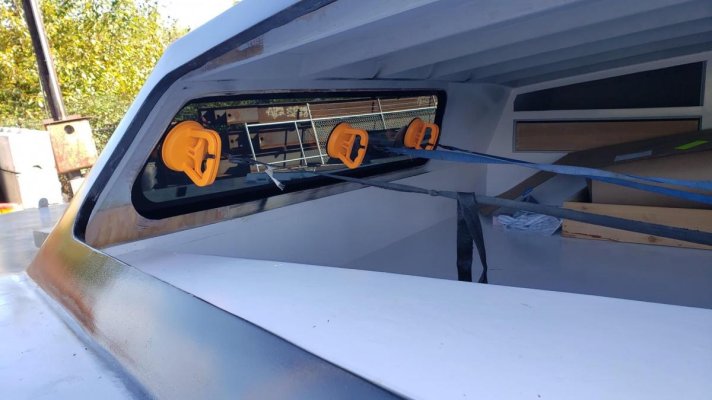Hi, I have a 1980 Hatteras37 with aluminum frames which are slowly but surely failing and leaking. I have replaced all of my window seals and followed Hatteras instructions but despite that, and new seals and sealant etc. some of my windows have started leaking again. \
I am musing the idea of removing the frames and window panes and replacing everything with true frameless windows. If I go that route, I would have to:
1. Glass in and fair around the entire opening. I am not sure Hatteras did that before installing the frames.
2. To install frameless windows, I am thinking of using the 3M VHB (Very High Bond) two sided tape along the outside opening
3. Cut the new window panes 1.5" larger than the opening.
4.Attach the window pane by placing over the VHB (I know that placing something over VHB is one attempt, so I would place temporary supports on the bottom side on which I would rest the glass pane and then press it against the VHB.
5. Fill the gap between the glass pane and VHB with good quality caulking. My window tops are recessed under the flybridge structure so only place where I will really need the caulking is on the sides and on the bottom, which is easily accessible.
6. Fabricate teak 'L' shape trim to cover the window opening that will rest against the glass, or perhaps apply a thin sponge insulation tape on the inside of the window pane and then rest the teak trim agains it.
The glass pane will be held in place by VHB tape and some caulking. No screws and no other support.
Has anyone done this?
I see it regularly done on new modern boats, even on rounded/curved windows.
I am musing the idea of removing the frames and window panes and replacing everything with true frameless windows. If I go that route, I would have to:
1. Glass in and fair around the entire opening. I am not sure Hatteras did that before installing the frames.
2. To install frameless windows, I am thinking of using the 3M VHB (Very High Bond) two sided tape along the outside opening
3. Cut the new window panes 1.5" larger than the opening.
4.Attach the window pane by placing over the VHB (I know that placing something over VHB is one attempt, so I would place temporary supports on the bottom side on which I would rest the glass pane and then press it against the VHB.
5. Fill the gap between the glass pane and VHB with good quality caulking. My window tops are recessed under the flybridge structure so only place where I will really need the caulking is on the sides and on the bottom, which is easily accessible.
6. Fabricate teak 'L' shape trim to cover the window opening that will rest against the glass, or perhaps apply a thin sponge insulation tape on the inside of the window pane and then rest the teak trim agains it.
The glass pane will be held in place by VHB tape and some caulking. No screws and no other support.
Has anyone done this?
I see it regularly done on new modern boats, even on rounded/curved windows.




